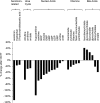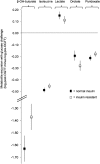Metabolite profiles during oral glucose challenge
- PMID: 23382451
- PMCID: PMC3717862
- DOI: 10.2337/db12-0754
Metabolite profiles during oral glucose challenge
Abstract
To identify distinct biological pathways of glucose metabolism, we conducted a systematic evaluation of biochemical changes after an oral glucose tolerance test (OGTT) in a community-based population. Metabolic profiling was performed on 377 nondiabetic Framingham Offspring cohort participants (mean age 57 years, 42% women, BMI 30 kg/m(2)) before and after OGTT. Changes in metabolite levels were evaluated with paired Student t tests, cluster-based analyses, and multivariable linear regression to examine differences associated with insulin resistance. Of 110 metabolites tested, 91 significantly changed with OGTT (P ≤ 0.0005 for all). Amino acids, β-hydroxybutyrate, and tricarboxylic acid cycle intermediates decreased after OGTT, and glycolysis products increased, consistent with physiological insulin actions. Other pathways affected by OGTT included decreases in serotonin derivatives, urea cycle metabolites, and B vitamins. We also observed an increase in conjugated, and a decrease in unconjugated, bile acids. Changes in β-hydroxybutyrate, isoleucine, lactate, and pyridoxate were blunted in those with insulin resistance. Our findings demonstrate changes in 91 metabolites representing distinct biological pathways that are perturbed in response to an OGTT. We also identify metabolite responses that distinguish individuals with and without insulin resistance. These findings suggest that unique metabolic phenotypes can be unmasked by OGTT in the prediabetic state.
Figures




Comment in
-
Metabolomics reveals unexpected responses to oral glucose.Diabetes. 2013 Aug;62(8):2651-3. doi: 10.2337/db13-0605. Diabetes. 2013. PMID: 23881193 Free PMC article. No abstract available.
References
-
- Centers for Disease Control and Prevention National Diabetes Fact Sheet: National Estimates and General Information on Diabetes and Prediabetes in the United States, 2011. Atlanta, GA, U.S. Department of Health and Human Services, Centers for Disease Control and Prevention, 2011
-
- Tuomilehto J, Lindström J, Eriksson JG, et al. Finnish Diabetes Prevention Study Group Prevention of type 2 diabetes mellitus by changes in lifestyle among subjects with impaired glucose tolerance. N Engl J Med 2001;344:1343–1350 - PubMed
Publication types
MeSH terms
Substances
Grants and funding
LinkOut - more resources
Full Text Sources
Other Literature Sources
Medical

